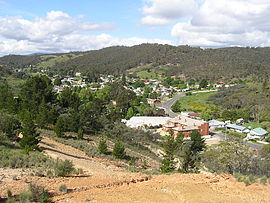| Main | Births etc |
|---|
| Captains Flat | |
 Captains Flat from Mine Hill | |
| Location in New South Wales | |
| Population: | 743 [1] |
| Established: | 1883 |
| Postcode: | 2623 |
| Location: | 61 km (38 mi) from Canberra |
| LGA: | Palerang Council |
| State District: | Monaro |
| Federal Division: | Eden-Monaro |
Captains Flat is a town in the Southern Tablelands of New South Wales, Australia, in Palerang Shire. It is south of Queanbeyan.
It is suggested that a bullock named "Captain" from Foxlow station, 12 km away, grazed here and hence the place name.[2]
The area was originally inhabited by Ngarigo Aboriginal people prior to European settlement. The town formed as a result of mining for gold, silver, lead, zinc, copper and iron pyrites in the hills surrounding the upper reaches of the Molonglo River. The town boomed from 1881 to 1899 then went into a rapid decline until 1939 when rail access revived mining activity for another 23 years.

Captains Flat mine in 1952
Copper was found in the area in 1874 by JE Wright of Foxlow station. The Molonglo goldfield was declared in 1882 and mining for gold and silver commenced at two mines, Koh-i-noor and Commodore, which were operated by two mining companies. Two blast furnaces were built in 1885. The two companies merged in 1894 and formed the Lake George United Mining and Smelting Company. Up to that time the mines had produced mainly copper with some silver and a small amount of gold. Processing was made harder because of the presence of zinc. To convey ore to the bins at the smelter, the company built a 2 ft (610mm) tramway in 1897. Trains of small 4-wheel dump cars were hauled by a Krauss steam locomotive. The tramway appears to have closed about 1902.[3] In the early twentieth century the mine produced gold and copper. Mining activity ceased in 1920.
The impact on European markets due to World War II meant mining operations were subsidised by the government through power and freight concessions as the foreign revenue was seen as important to the Australian economy. In 1940, 550 people were employed and the local population was 1700. The mining company, Lake George Mines, built 152 fibro cottages for married miners, a hostel for single men and some of the population lived in tents. The company also built a theatre, hospital tennis courts and a swimming pool, paid for the medical staff, the provision of street lighting, electricity and water.

Captains Flat Hotel
In the 1930s and 40s many of the old buildings were replaced including the hotel. The new hotel built in 1938 was said to have the longest bar in Australia at the time; it was 32 metres long.
There were some significant strikes by the miners in the 1940s and 50s. The strike of 1948/49 and the lockout of 1954/55 both lasted for seven months. The mine closed on 11 March 1962 due to the lack of viable ore. To that point men had worked in tunnels extending 840 metres (2,800 feet) below the ground. From 1939 to 1962 just over 4 million tonnes of ore was extracted containing 1.5 million tonnes of concentrates: 39% of which were zinc, 33% pyrites, 24% lead, 5% copper, and small amounts of gold (2850 tonnes) and silver (155 tonnes). Immediately after the closure the Lake George Mines dismantled and sold the infrastructure including removing many of the cottages.

Evidence of the past mining activity remains above Captains Flat with a stream that flows into the Molonglo River
The Captains Flat railway line from Bungendore opened in 1940 with tri-weekly service. This was reduced to once a week following the closure of the mine. The railway was booked out of use on 31 August 1968 but reopened for a few weeks in 1969 for the filming of the movie "Ned Kelly".
The impact of sulphur and acid rain produced by the smelting has resulted in the area around the mines having a stark and somewhat alien landscape reminiscent of Queenstown in Tasmania.
In the 1939 and 1942 mine tailings and slime dams collapsed into the Molonglo River. The resulting pollution severely damaged the ecological communities of the Molonglo River downstream from the mine site, and eradicated all native fish populations. Despite Federal and NSW government funded remediation programs of $2.5m in 1976, toxic leachates still enter the river from the Captains Flat mine site. The remediation works covered the waste dumps with impermeable clay and vegetation designed to reduce the risk of catatastrophic failure of the dumps. The owners of the mine were not held accountable for the pollution nor contributed to the remediation of the environmental impact. A large stretch of the Molonglo is still devoid of native fish and waiting for native fish species to be re-established.
Prospecting has commenced in the area again, begun by Monaro Mining and apparently now largely taken over by Ironbark Gold.
Notable people[]
- Mark Gable - Singer and songwriter for The Choirboys, was born in Captains Flat.
References[]
- ^ Australian Bureau of Statistics (31 October 2012). "Captains Flat (State Suburb)". 2011 Census QuickStats. http://www.censusdata.abs.gov.au/census_services/getproduct/census/2011/quickstat/SSC10460?opendocument&navpos=220. Retrieved 30 January 2014.
- ^ Welcome to Captains Flat
- ^ The Captain's Flat Mines Tramway Macdonald, Bruce & Longworth, Jim Australian Railway Historical Society Bulletin, September, 1994 pp253-256
External links[]
Media related to Captains Flat, New South Wales at Wikimedia Commons
- Webpage of the Captains Flat Community Association containing numerous internal and external links to interesting information about the village and surrounding area.
| |||||||||||
| This page uses content from the English language Wikipedia. The original content was at Captains Flat. The list of authors can be seen in the page history. As with this Familypedia wiki, the content of Wikipedia is available under the Creative Commons License. |
